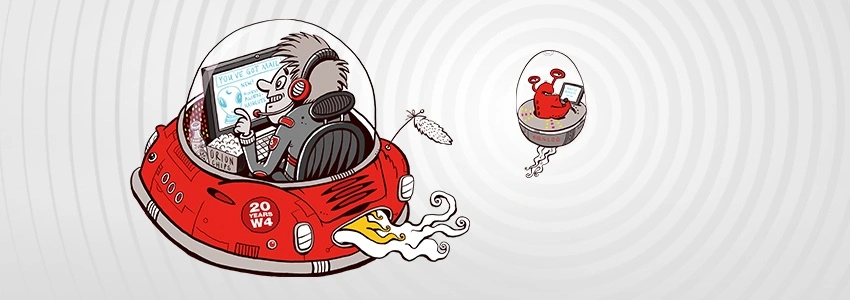In email marketing, personalized emails that include first names in the salutation have long been standard practice. What used to stand out now has no effect if the content, timing, and context are not right. If you want to generate relevance in the inbox, you need more than simple placeholders.
This is where hyper-personalization comes in. It combines CRM data, user behavior, and marketing automation into a system that not only makes content appear individualized, but also responds specifically to situations. Timing, tone, and content are not based on gut feeling, but on concrete data points.
What sounds like a lot of effort can be implemented in a structured and scalable way. The key lies not in complex tools, but in a clear approach. In this article, we show you why hyper-personalization makes the difference and how you can implement it step by step.
What is hyper-personalization?

Hyper-personalization describes an approach in which content is not only superficially adapted, but specifically tailored to the context of the recipient. It is based on real-time data, user behavior, and the individual status within the customer journey.
Unlike traditional personalization, which usually ends with names, segments, or fixed rules, hyper-personalization is based on dynamic, behavior-driven mechanisms.
The goal is to provide content that is relevant to the time, situation, and needs of the individual. For example, if a user opens a specific product page multiple times and repeatedly reads a FAQ section on integration into existing systems, they can be offered a use case article or an invitation to a relevant webinar at the exact moment when their interest is highest.
A recent study from 2025 shows that 39 percent of email marketing professionals surveyed attribute the greatest influence on automation campaigns to AI-powered hyper-personalization. The relevance of this approach is thus clearly demonstrated.
Typical features:
- Behavior-based content: Clicks, page visits, or previous purchases determine which information is displayed.
- Dynamic building blocks: Texts and offers automatically adapt to individual profiles and usage patterns.
- Life cycle orientation: The content is tailored to the status and phase of the contact, for example, new customer, existing customer, or inactive user.
- AI-supported systems: Tools analyze data, make predictions, and enable the automated delivery of highly relevant content
Thanks to modern CRM and marketing platforms, hyper-personalization can now be implemented without internal data teams. The effect goes beyond metrics such as open rates. Companies that consistently pursue this approach report measurably higher engagement, longer customer loyalty, and improved conversion rates.
Why is hyper-personalization crucial today?
Digital users have learned to instinctively ignore irrelevant content. A first name in the subject line is no longer enough to grab attention. Today, when people open an email, they expect substance – personalized, contextually relevant, and delivered at the right time.
The challenge: inboxes are overflowing, and tolerance for generic messages is zero. At the same time, many companies have long had the necessary data at their disposal but do not use it consistently. This leads to wasted coverage, declining open rates, and increasing unsubscribes.
Hyperpersonalization addresses precisely this problem. It brings back relevance – driven by behavior, enriched with real-time data, and implemented through automation.
Used correctly, it creates communication that works.
In concrete terms, this means:
- Content is based on individual behavior, not rigid segments
- Offers are based on genuine interest, not assumptions
- Communication feels personal, but remains scalable
Companies that don't hyper-personalize today are running into a dead end. Those who only make superficial adjustments remain interchangeable. Those who communicate in a context-sensitive manner, on the other hand, remain present – in the inbox and in the minds of the target group.
Our six steps to successful hyper-personalization
1. Create a clear basis: What do you offer, to whom, and why?
Before data flows are defined or automations are built, every campaign needs a solid content foundation. The central question here is: What exactly is being offered, to whom, and with what goal?
Many campaigns fail not because of technology, but because of a lack of clarity in what is being offered. It is often unclear which product is the focus, what benefits it addresses, or what specific action should be triggered. This uncertainty about content runs through the entire personalization chain – from the data model to the delivery.
Therefore:
- What exactly are we offering?
- For which target group?
- What specific problem are we solving with it?
Only when these questions have been clearly answered can the rest be managed efficiently. This applies not only to texts and CTAs, but also to the selection of relevant data, content, and triggers.
Hyper-personalization only works if the core content is right. Without a clear message, even the most technically perfect campaign will be ineffective.
The first step is therefore always strategic. If you do this properly, you lay the foundation for precise, converting communication – and save yourself correction loops later on.
2. Tap into relevant data: Build customer intelligence

Personalization needs context. If you really want to tailor emails to individual recipients, you need to know more than just their first name or segment. Relevance can only be achieved by taking behavior, timing, and history into account.
The basis for this is a networked, clean database. It is not enough to track clicks or store purchase data somewhere. It is crucial that information is centrally available and can be used at the right moment.
This includes, for example:
- CRM data such as past purchases, contract status, or service contacts
- Behavioral data such as click paths, dwell time, or scroll depth
- Transaction data such as purchase frequency, shopping cart value, or returns
- Interaction data such as opens, clicks, or form usage
In many companies, this information is already available – but it is spread across different tools, incomplete or out of date. This is precisely where the bottleneck lies.
Customer intelligence does not mean collecting as much data as possible. It means identifying relevant information, linking it and making it available – both technically and in terms of content marketing.
In practice, this means
- Integrating systems, e.g., CRM, web tracking, e-commerce
- Cleaning and synchronizing data
- Creating access points where this data is available in real time
Only when this structure is in place can truly relevant emails be sent out. Without it, personalization remains a promise – but not a functioning process.
3. Build a memory: make communication traceable
Hyper-personalization is not just about delivering the next most relevant content. It also means knowing what has already happened. Without this context, even well-intentioned messages come across as arbitrary or intrusive.
Has the person already seen the offer? Was it opened but ignored? Did a conversion take place or not?
If you don't keep track of this, you run the risk of repeating yourself. And repetitions without context are quickly perceived as spam.
What you need: a central memory. Not in the form of Excel lists, but directly in the system that sends the emails. It must recognize which content has already been played, what reactions it elicited, and how the next meaningful action can be derived from this.
HubSpot offers a good foundation for this. CRM, email history, and automation rules all work together. This allows you to manage contacts in a targeted manner based on their previous behavior, not on assumptions.
Real-world examples:
- If someone has rejected a product twice, they shouldn't receive the same email a third time.
- Those who clicked but did not buy need a follow-up with a benefit argument or social proof.
- Those who missed a promotion do not need a review, but a new offer.
Most tools show openings and clicks. The question is whether lessons are learned from this. Only when this information is actively incorporated into the campaign logic can consistent communication be achieved.
A functioning system ensures that every message builds on the last one and does not start from scratch.
4. Connect systems: Technical infrastructure for real-time personalization
Data alone is useless if it is not available at the right time and in the right place. Even a clean CRM is useless if marketing, sales, and email tools do not communicate with each other. Hyper-personalization requires an infrastructure that not only stores data but also utilizes it. And it does so where decisions are made.
In practice, this means that systems must be integrated. Customer data, website interactions, purchases, and service contacts must not be stored in isolation. They must be evaluated centrally and made available in real time. Only then can a campaign respond dynamically.
What you need
- A direct connection between CRM, web tracking, shop, and support systems
- A platform or middleware that provides information across systems. This can be a customer data platform, an automation solution with webhooks, or an API-supported in-house development
- Decision logic that recognizes when which contact should receive which message
Example:
A person visits your website, looks at a product, but leaves without making a purchase. This behavior must be recognized by tracking and transferred to the CRM. There it is evaluated and forwarded to the email system, which automatically generates an appropriate response. No manual intervention is required.
Technically, this is feasible. The challenge lies in the interaction between the systems. Consistent integration lays the foundation for true relevance at the right moment.
5. Create content dynamically: Scalable, context-based communication

Relevant content does not come from individual mailings, but from a system. The goal is to automatically compile the right content based on existing data. This can only be achieved if content is modular and can be flexibly combined depending on the context.
This requires three key elements:
- Modular templates. The email does not consist of a fixed text, but of building blocks that can be shown or hidden depending on the recipient profile.
- Tagged content. Every text module, every image, and every recommendation is clearly assigned. For example, to a product, a stage in the purchasing process, or user behavior.
- Control logic. Conditions are used to define when which content is displayed. For example: If a user has viewed product A but not purchased it, show a use case or customer review for product A.
It is important that the combination of content works even if individual data is missing. The system must remain stable even if, for example, no product interest has been detected or no conversion has taken place.
Dynamic content does not mean more work per email, but rather a better basic structure. Instead of many individual versions, you get a system that can be maintained and expanded in the long term.
6. Learn and optimize: Integrate feedback loops
Personalization does not end with the dispatch. What happens afterwards is crucial. Only if opens, clicks, conversions, and responses are systematically evaluated can the campaign be further developed in a targeted manner.
This requires measurable feedback signals and an infrastructure that turns them into usable information. It is not enough to look at individual metrics in reports. The insights gained must be automatically incorporated into the next step.
Specific elements of a functioning feedback loop:
- Tracking at the content level: Not just open rates, but precise evaluation of which modules were viewed and clicked on.
- Segmentation based on behavior: Users who repeatedly fail to respond are addressed differently than those with high interaction.
- Automated follow-up: Those who click but do not convert receive an alternative message. Those who are active but do not complete a purchase are prioritized.
Technically, this can be implemented using common marketing platforms. It is important that rules and evaluations are clearly documented and traceable. This is the only way to avoid optimizations running into the ground or requiring manual intervention.
Feedback is not an extra. It is part of the system. If you don't close the loop at this point, you are wasting potential and risking personalization becoming a one-way street.
Hubspot as a companion for hyper-personalization

HubSpot bundles all the central functions required for true hyper-personalization – from data collection and automation to dynamic content control. At the heart of it all is the CRM, which not only collects master data, but also interactions such as page views, form submissions, and email clicks in real time and makes them available for use.
This forms the basis for automated workflows that deliver content in a targeted manner. Users who visit a product page but do not convert receive follow-up emails with relevant information or references. Anyone who downloads a white paper is automatically assigned a thematically appropriate series. Reactivation measures for inactive contacts can also be fully automated.
Smart content is a central component of personalization at the content level. It allows texts, calls to action, and content on websites, landing pages, and in emails to be automatically varied depending on target group characteristics or user behavior. New visitors see a different message than existing customers. Users from industry A receive different arguments than users from industry B – without the need to maintain multiple versions.
All interactions flow seamlessly back into reporting. Opens, clicks, conversion goals, and behavior patterns can be systematically evaluated and used to optimize workflows and content. This creates a feedback loop that not only reveals what works, but also helps to control the next step based on data.
HubSpot is therefore not a single tool in the tech stack, but a platform that combines CRM, automation, personalization, and analysis in a single interface. This reduces interfaces, speeds up processes, and creates the conditions for not only implementing personalization, but also developing it in a controlled manner.
In summary...
Hyperpersonalization is effective when it is understood as a well-thought-out process, not as a single measure. Relevance does not come from tools, but from structure, clarity, and clean implementation.
Consistently aligning content, data, and systems creates the foundation for communication that doesn't look like a campaign, but like genuine closeness. That means less generic distribution and more targeted impact.
The prerequisites for this are often already in place. The key is to use them correctly.
Effective hyper-personalization with W4
As a HubSpot Diamond Partner, we support you in not only implementing hyper-personalization technically, but also making it operationally usable. From clean data structures and intelligent segmentation to dynamic content and automated workflows, we help you efficiently connect all the building blocks.
Whether CRM, smart content, lead nurturing, or real-time communication, we show you how to fully leverage the power of HubSpot and take your email campaigns to the next level.
Talk to us about your goals and learn how to effectively use hyper-personalization in HubSpot. Transparent, scalable, and with real added value for your marketing.










